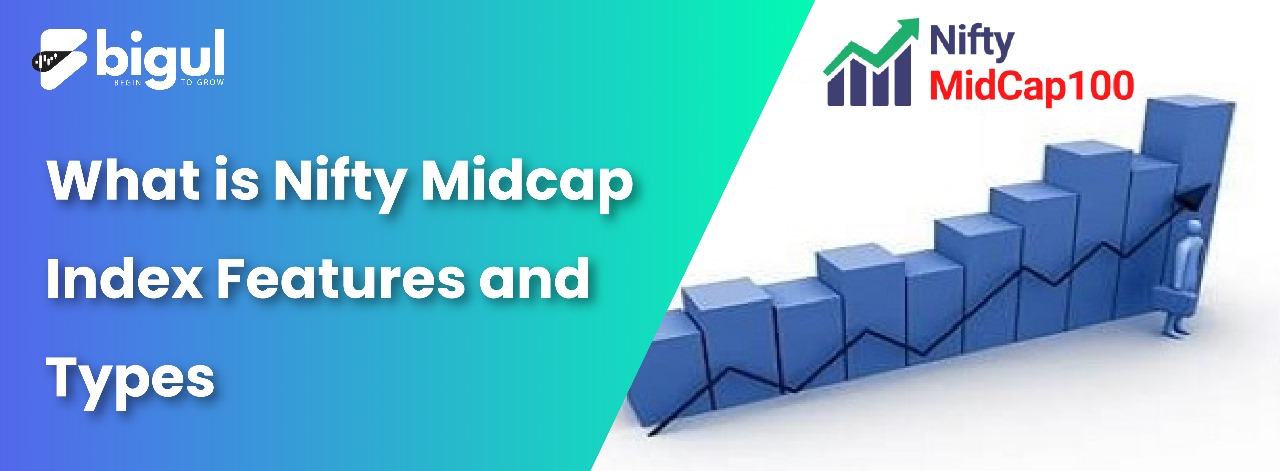The Nifty Midcap Index holds a crucial position in the landscape of India’s stock market. It serves as a barometer of the performance of mid-sized companies. It encompasses a diverse range of stocks, occupying a market Capitalisation range that bridges the gap between large-cap stalwarts and small-cap upstarts. As investors seek to balance risk and reward, understanding the features and types of the Nifty Midcap Index becomes essential. This article discusses the key properties of this index and its various types.
Also Read | US Fed Actions boiling the Dollar Index: Let us understand what it is?
What is the Nifty Midcap Index?
The Nifty Midcap Index is a vital benchmark in the Indian stock market, comprising mid-sized companies that fall between large-cap and small-cap categories. It tracks the performance of these midcap stocks, offering investors insight into this crucial segment of the market. With its diverse sector representation and historical performance data, the Nifty Midcap Index serves as a valuable tool for assessing midcap stock performance. This allows investors to make informed decisions and diversify their portfolios effectively.
Features of Nifty Midcap Index
The Nifty Midcap Index has several distinctive features that make it an integral component of investment strategies and market analysis:
1. Market Capitalisation Range
The Nifty Midcap Index encompasses companies within a specific market Capitalisation range, typically falling between those of large-cap and small-cap stocks. While there’s no rigid market Capitalisation limit, it primarily includes firms ranked between the 101st and 250th positions based on full-market Capitalisation. This range distinguishes midcap stocks from both larger, more established companies and smaller, riskier ventures. This offers investors exposure to a diverse set of companies that are often poised for growth while still maintaining a certain level of stability compared to small caps.
2. Diverse Sector Representation
The Nifty Midcap Index includes finance, technology, healthcare, and consumer goods. This diversity serves to spread risk across various sectors, reducing the impact of sector-specific downturns on the index’s overall performance. Investors benefit from exposure to multiple industries, making the index a valuable tool for mitigating concentration risk and tapping into the growth potential of mid-sized companies across different sectors in the Indian stock market.
3. Historical Performance
The Nifty Midcap Index has exhibited a strong track record of delivering attractive returns over time. It has often surpassed the performance of the broader Nifty 50 Index, making it an appealing choice for investors looking for capital appreciation. This historical outperformance underscores the potential for midcap stocks to generate substantial returns and highlights the index’s role as a barometer of mid-sized company performance within the Indian stock market.
4. Investment Opportunities
The Nifty Midcap Index presents compelling investment prospects, as midcap stocks offer an attractive balance between growth potential and stability. These companies often have room for expansion and innovation, making them appealing to investors seeking higher returns. The dynamic nature of midcap stocks can lead to rapid value appreciation. This makes them a favored choice for those willing to accept a degree of volatility in pursuit of capital appreciation in the Indian stock market.
5. Liquidity and Trading Volume
Many of the stocks included in the Nifty Midcap Index have sufficient liquidity and trading volume. This means that investors can buy or sell these stocks with ease and without causing significant price fluctuations. Liquidity is a vital factor for investors as it ensures that their orders can be executed efficiently at prevailing market prices. This makes the Nifty Midcap Index stocks accessible and tradable for a wide range of market participants.
6. Risk and Volatility
Midcap stocks can be more prone to price swings compared to larger companies. This volatility can create both opportunities and risks for investors. While midcaps offer growth potential, their prices can fluctuate significantly, leading to potential gains but also heightened exposure to market turbulence. Investors need to carefully assess their risk tolerance and investment horizon when considering midcap stocks due to this inherent volatility.
Types of Nifty Midcap Indices
There are several types of Nifty Midcap Indices, each designed to serve specific investment needs and objectives. Here are the primary types:
- Nifty Midcap 50
- Nifty Free Float Midcap 100
- Nifty Midcap 150
Let’s break down these three types of nifty midcap indices.
1. Nifty Free Float Midcap 100
This index consists of 100 mid-cap stocks selected from the Nifty Midcap 150 universe. The term “free float” refers to the portion of shares available for trading by the public. This index is calculated using free float market Capitalisation-weighted methodology, which considers only the freely tradable shares for determining the stock’s weight in the index. The Nifty Free Float Midcap 100 offers a more refined view of midcap stocks by focusing on those with higher liquidity.
2. Nifty Midcap 150
The Nifty Midcap 150 Index is a comprehensive benchmark comprising 150 mid-sized Indian companies selected from the Nifty Free Float Midcap Index. It offers investors a broader exposure to midcap stocks, spanning various sectors and industries. This index is suitable for those seeking a diversified midcap portfolio, providing a more extensive and inclusive representation of mid-sized companies in India’s stock market. This,thereby, reduces concentration risk while still capturing the potential for growth in this segment.
3. Nifty Midcap 50
The Nifty Midcap 50 is like a special list of 50 mid-sized companies from the bigger group of midcap stocks. These 50 companies are some of the most important and easy-to-trade midcap stocks. People who want to invest in these particular mid-sized companies might like this list because it helps them focus on the top 50, making their investment choices simpler and more direct. It’s a bit like picking the best 50 out of a larger group.
Difference Between Nifty Midcap 50, Nifty Midcap 100 and Nifty Midcap 150
Here’s are the key differences between Nifty Midcap 50, Nifty Midcap 100, and Nifty Midcap 150 indices:
| Aspect | Nifty Midcap 50 | Nifty Midcap 100 | Nifty Midcap 150 |
| Number of Constituents | 50 | 100 | 150 |
| Market Capitalisation Range | Mid-sized companies | Mid-sized companies | Mid-sized companies |
| Diversification | Concentrated | Balanced | Broad |
| Sector Representation | Varied | Varied | Varied |
| Investment Focus | High potential stocks | Balanced approach | Broader market exposure |
| Liquidity | Moderate to higher liquidity | Moderate liquidity | May have lower liquidity |
| Risk and Return | Potentially higher risk, higher return | Balanced risk and return | Lower risk, potentially lower return |
| Index Weighting Method | Free float market cap | Free float market cap | Free float market cap |
| Benchmark for Midcap Stocks | Represents a subset | Represents a broader set | Represents a much broader set |
| Investment Strategy Implication | For investors seeking more aggressive growth | Suitable for a balanced approach | For a more conservative approach |
Methodology for Nifty Midcap Index Calculation
The Nifty Midcap Index’s reliability and efficacy as a benchmark for mid-sized Indian stock market companies depend on its calculation technique. Some significant elements of this methodology:
1. Review and Rebalancing Frequency
The Nifty Midcap Index follows a market Capitalisation-based approach, where companies’ influence on the index is determined by their market value. Companies with larger market Capitalisations hold more significant weight in the index, reflecting their greater importance within the midcap segment.
This methodology ensures that the index accurately represents the relative size and impact of mid-sized companies in the Indian stock market.
2. Market Capitalisation Weighting
The Nifty Midcap Index employs a market Capitalisation-weighted approach, where companies’ influence on the index is proportional to their market value. This means that midcap stocks with larger market Capitalisations carry greater weightage in the index, reflecting their significance. A company’s market Capitalisation is its stock price multiplied by its outstanding shares. By accounting for midcap enterprises’ different sizes, this methodology assures that the index appropriately portrays mid-sized company performance.
3. Inclusion and Exclusion Criteria
To be part of the index, firms must meet specific requirements, mainly centered on market Capitalisation thresholds. These criteria ensure that the index comprises a representative sample of mid-sized companies in the Indian stock market. Companies failing to meet these criteria, often due to shrinking market Capitalisation, can be removed from the index during semi-annual reviews in March and September.
4. Adjustments for Corporate Actions
Corporate actions like stock splits, mergers, and bonus issues can alter a company’s market Capitalisation and its weight in the Nifty Midcap Index. The index methodology includes mechanisms to account for these actions to maintain its accuracy and relevance. This ensures that the index reflects the true performance of midcap stocks by mitigating the impact of corporate events that may artificially inflate or deflate a company’s market Capitalisation.
Conclusion
The Nifty Midcap Index emerges as a vital instrument for investors seeking a balanced exposure to India’s stock market. Its diverse sector representation and historical performance showcase its resilience and potential for growth. With various types of Nifty Midcap Indices available, investors can tailor their strategies to suit their risk tolerance and objectives. Whether used for portfolio diversification or as a benchmark for midcap stock performance, the Nifty Midcap Index offers valuable insights and opportunities in the dynamic realm of Indian equities.
Also Read | JP Morgan to Include Indian Government Bonds in Emerging Market Debt Index







.jpg)
.jpg)
